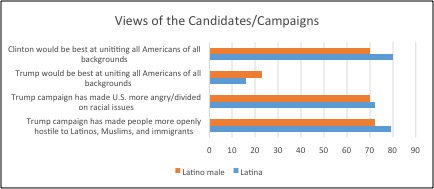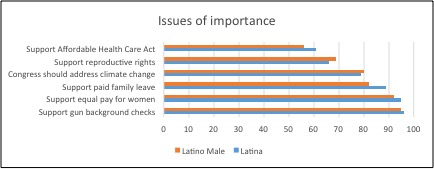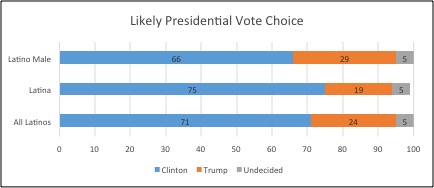Racial and Gender Reminders for Campaign Appeals
 In April 2015, the Barbara Lee Family Foundation (BLFF) and the Center for American Women and Politics (CAWP) launched Presidential Gender Watch 2016, a project to track, analyze, and illuminate gender dynamics in the 2016 presidential election. With the help of expert scholars and practitioners, Presidential Gender Watch worked for 21 months to further public understanding of how gender influences candidate strategy, voter engagement and expectations, media coverage, and electoral outcomes in campaigns for the nation’s highest executive office. The blog below was written for Presidential Gender Watch 2016, as part of our collective effort to raise questions, suggest answers, and complicate popular discussions about gender’s role in the presidential race.
In April 2015, the Barbara Lee Family Foundation (BLFF) and the Center for American Women and Politics (CAWP) launched Presidential Gender Watch 2016, a project to track, analyze, and illuminate gender dynamics in the 2016 presidential election. With the help of expert scholars and practitioners, Presidential Gender Watch worked for 21 months to further public understanding of how gender influences candidate strategy, voter engagement and expectations, media coverage, and electoral outcomes in campaigns for the nation’s highest executive office. The blog below was written for Presidential Gender Watch 2016, as part of our collective effort to raise questions, suggest answers, and complicate popular discussions about gender’s role in the presidential race.
Many of us watched the first presidential debate last week nervously. You may have watched to assess how the two candidates addressed one particular issue of importance or to get an overall evaluation of the candidates. But for scholars of gender and race, the key question was if the two candidates would directly address important issues of diversity.
In terms of gender and race, both candidates touched briefly on a few relevant issues, but neither devoted much time to appealing to the growing portion of the electorate that stands at the intersection of racial and gender diversity. In one instance, the candidates were asked a very broad question about addressing “race in America.” The resulting discussion focused on growing racial tensions in the country centered on police violence and inner city crime. This makes sense: minority communities are deeply worried about growing violence in the country. They are also concerned about critical immigration policies. But it is important to point out they are also concerned about the effects of other public policies on their lives, not simply those that appear so explicitly racialized. Minority communities prioritize a variety of issues, and the campaigns need to acknowledge how policies impact diverse communities. In particular, it is wise for campaigns to acknowledge and court minority women in their appeals, as this emerging electorate proved integral to President Obama’s victories in both 2008 and 2012.
Latinos are an influential bloc of swing voters in the election, especially in battleground states. Recent polling data, from Latino Decisions, provides a gendered glimpse of Latino political attitudes this campaign season (Latino Victory Project/LD Latino Battleground Poll July 2016). There are several takeaways from recent polls about Latinos in the politically important battleground states (AZ, CO, FL, GA, IA, MI, NC, NV, OH, PA, VA, WI)

1. Divergent Views of the Candidates and Campaigns: A majority of Latinos agree that the Trump campaign has made the U.S. more angry and divided on racial issues. Latinos report this hostility has also resulted in more people being more openly hostile to Latinos, Muslims, and immigrants. Latinas, in particular, report more misgivings about the negative repercussions of Trump’s campaign. As a result, a majority of Latinos, 75 percent, agreed that Hillary Clinton is the best candidate to unite all Americans of all backgrounds. There is a gender gap with 80 percent of Latinas expressing support for Clinton as a unifier, compared to 70 percent of Latino males.

2. Multiple Issues of Importance: The common assumption is that Latinos only feel strongly about one policy issue, the renewed attempts at comprehensive immigration reform. Yes, an overwhelming majority, as high as 82 percent, of Latinos do feel strongly about comprehensive immigration reform especially in light of increased anti-Latino or anti-immigrant attitudes. However, Latinos, like all other communities in the U.S., are deeply concerned about a variety of policy issues in this election that can have important ramifications for their lives. For example, Latinos in battleground states care about the environment, including the call for Congress to address climate change by supporting clean energy technology and jobs. A majority of Latinos also support reproductive rights, paid family leave, equal pay for women, and the Affordable Health Care Act. In light of increased gun violence, the majority of Latinos also support increased gun control, including background checks. Across these issues, Latinos demonstrate support for more liberal public policies. There are also small gender gaps, with Latinas supporting slightly more liberal policies than Latino men. In addition, a majority of Latinos in battleground states express support for the Democratic Party, with 64 percent reporting they agree more with the Democratic Party on issues that are important to them. A gender gap is evident, with 67 percent of Latinas reporting support for the Democratic Party, compared to 61 percent of Latino males.
3. Majority Support to Clinton but Low Levels of Latino Outreach: A majority of Latinos, 71 percent, express their intent to support Clinton in the election. A gender gap of at least 9 points is also evident in the vote choice, with 75 percent of Latinas intending to vote for Clinton, compared to 66 percent of Latino males. In terms of the appeals to Latinos, there is increasing criticism that the major parties are missing a huge opportunity to address this growing population. For example, as recently as the beginning of September, a majority of Latinos, 60 percent, reported they had not received contact from a campaign, political party, or community organization over the past few months to encourage them to register or vote.

Recent news stories highlight frustration over the missed opportunities to fully incorporate more Latinos in the campaign process as campaign staff, consultants, organizations, and as potential voters. Congressional Hispanic Democrats have questioned “their party’s approach to campaigning in Latino communities.” So far, the Clinton and Trump campaigns are utilizing very different Latino outreach attempts. The Trump campaign has chosen to not buy any Spanish-language television or radio ads or to offer a translation of the campaign website into Spanish. The Clinton campaign has just begun to run Spanish-language ads in Nevada and Florida, and they provide Spanish-language translation of her website. Latino Democrats are also concerned that the Clinton campaign is not doing enough to mobilize Latino voters, which can hurt other Democratic candidates in the election. Instead, the Clinton campaign may be relying on backlash over repeated Trump attacks on the Latino community.
Most recently, Trump’s repeated attacks on former Miss Universe Alicia Machado, which include crude and racist remarks about women and Latinas in particular, is drawing increased criticism. This attack demonstrates Trump’s lack of concern or even particular interest in campaign outreach toward Latinas. Instead, Trump continues to further alienate the Latino community, Latinas specifically. In direct contrast, the Clinton campaign continues to engage in a Latina-specific campaign strategy, which demonstrates her acknowledgement of this important electorate and some clear gender gaps in her favor.
As this election draws closer and the campaigns narrow their strategic appeals to even fewer battleground states, the strategy may leave more diverse communities out of the campaign limelight. As these important constituencies continue to push to make their voices heard in the campaign, all concerned parties would be wise to pay attention to their intersecting interests.

